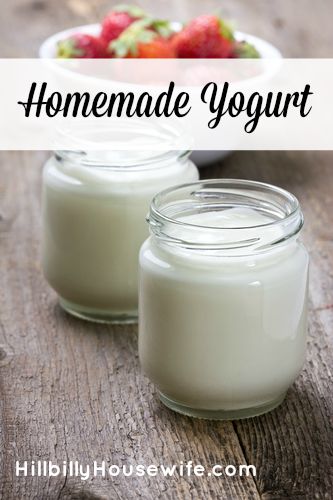Homemade Yogurt
- 3-3/4 cup warm tap water
- 1-2/3 cups instant nonfat dry milk
- 2 to 4 tablespoon store-bought, plain yogurt with active yogurt cultures (read the label to be sure)
In a large saucepan combine the tap water and dry milk powder. Stir it very well, and let it sit a few minutes. Then stir it again. All of the dry milk should be dissolved. Heat the milk over medium low heat until it reaches 180°. This kills off any competing bacteria so that the yogurt will respond better to the acidophilus cultures. Remove from the stove and allow to cool to 115°. If the milk is any hotter than this then it will kill off the yogurt cultures. Add the store-bought plain yogurt to the warm milk. Stir well. Allow it sit for a few minutes and stir a final time. This should dissolve the store-bought yogurt completely.
Carefully pour the mixture into a very clean, quart-sized, wide-mouthed canning jar, or another clean, quart-sized container.
Incubate the yogurt in a warm spot for 6 to 8 hours, or until it is set almost as thick as store-bought yogurt. Chill and eat.
Each cook develops her own way of incubating home made yogurt through trial and error. I am going to describe my method, followed by some other common methods and ideas. But first there are a few things you need to know. Yogurt is cultured from acidophilous bacteria, which you can sometimes buy in powdered form at the health food store. I have never actually seen it, but I’ve heard tell about it.
Yogurt can also be cultured from store-bought yogurt which contains “active yogurt cultures” or live bacteria. Read the label and it will tell you if the yogurt contains active cultures or not.
I always use prepared yogurt as my culture. I buy a large container of plain store brand yogurt from the store. I bring it home and scoop it into a couple of icecube trays. Then I freeze it. When it is completely frozen, I take the frozen yogurt cubes and pack them in a plastic freezer bag. Each time I make yogurt, I use one cube as the starter. You can use your own fresh yogurt as a starter too, but eventually it loses it’s power due to the introduction of foreign bacteria, usually after using it about 3 or 4 times. I like to use a new frozen yogurt cube each time I prepare yogurt. I’ve had my best results this way.
When making yogurt with powdered milk, it is good to use more dry milk powder than you would to just make fluid milk. For instance, normally I would use 1 1/3 cups of dry milk powder to make a quart of milk. When I reconstitute milk for yogurt, I add an extra 1/3 cup of dry milk powder, using 1-2/3 cups of dry milk powder for a quart of yogurt. This makes the yogurt thicker and also higher in calcium. Even when preparing yogurt from fluid milk, the results are better if you add a little extra powdered milk for thickness.
There are lots of ways to incubate your yogurt. I prefer to do it in my electric oven. I set the stove dial half way between OFF and 200°, or at approximately 100°. The light which signifies the oven is on, pops on for a moment, and then pops off when the temperature is reached. I set my jar of yogurt in the oven and leave it for between 6 and 8 hours, usually overnight, or while I’m out for the day. I take out the yogurt when it is thick. This method works every time for me. My yogurt has a very mild flavor, which the kids like better than the sour stuff we used to get from the store.

There are many other ways to incubate your yogurt. Some people pour the warm milk combined with the starter, into a large preheated thermos and let it sit overnight. Other folks set the yogurt on top of a warm radiator, or close to a wood stove, or in a gas stove with the pilot operating, or on a heating pad set on low. Sometimes I have placed the jar in a pan filled with warm water, to keep the temperature even. This worked pretty well when I incubated the yogurt next to the wood stove. It kept the yogurt at a uniform temperature, even with occasional drafts from the front door opening and closing. The heating-pad method is supposed to be pretty reliable. You set it on low and then cover the heating pad with a towel, place the yogurt on top of it, and put a large bowl or stew pot upside down over the yogurt. This makes a little tent which keeps the heat in. I don’t have a heating pad, and have never actually used this method myself, but a good friend swears by it. Another friend uses a medium sized picnic cooler to incubate her yogurt. She places the jars inside the cooler and then add two jars filled with hot tap water, to keep the temperature warm enough. After 4 hours, check the yogurt to see if it is thick enough. If it isn’t then refill the water jars with more hot water, return them to the cooler, and let the yogurt sit another 4 hours. When I tried this method, it worked very well. It took a full 8 hours, but the yogurt was perfect, and I liked not having my oven tied up during the day. Also, there was little danger of getting the yogurt too hot while it incubated, and drafts weren’t a problem because of the closed nature of the cooler. You should try to disturb the yogurt as little as possible while it is incubating, in ensure you get good results.
After the yogurt is thick, place it in the fridge. It will stay sweet and fresh for about a week or two. You may prepare more than one jar at a time if you like. I included the method for a quart because this is the size canning jar I use. Narrow mouth canning jars would probably work too, but I prefer the wide mouth ones because it is easier to stick a measuring cup or ladel down inside of it, to scoop out the yogurt. I usually prepare two quart jars at a time. The prepared yogurt is good mixed with jelly, fresh or canned fruit, served with granola for breakfast, or substituted for sour cream in many recipes like stroganoffs. It is also nice pureed in fruit smoothie blender drinks, or stirred into gelatin or popscicles before freezing them. It can also be stirred half and half with regular mayonnaise to make a very tasty low fat mayonnaise. This mixture can be used in just about any recipe which calls for mayonnaise.
Learning to make yogurt is a trial and error process. Most people don’t have perfect or consistant results the first few times they make it. With a little practice though, anyone can learn to make it. When you get a little skill at it, the entire process becomes second nature, and you will have sweet fresh yogurt available whenever you like.
To support the blog, check out the HBHW eBooks available on Amazon. Thank you!
Disclosure: Some of the links below are affilate links, meaning, at no additional cost to you, I will earn a commission if you click through and make a purchase.

